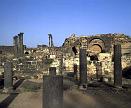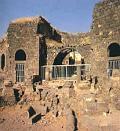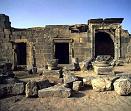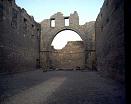| |
Introduction: 
Bosra (Busra Ash Sham) sits on a fertile plain littered with black basalt about 40km east of Daraa, and 140 Km south of Damascus in the Horan plain. The ancient city of Bosra is famous for its impressive and beautiful Roman theatre. When it was in use, the theatre was faced with marble and draped in silk, and during performances a fine mist of perfumed water was sprayed over the patrons to keep them comfy. It is an unusual structure in that it has a fortress built around it, probably constructed during the Omayyad and Abbasid periods. It is this fortress, which has defended and preserved the theatre, accounting for its excellent state of repair today. The theatre seated 15,000 people and, unlike other Roman theatres, which were built into a hillside, this building is freestanding. This city of Bosra, was first mentioned in the Hieroglyphics of Thutmos III and Akhenaton in the 14th century BC, and 1000
years later was the capital of the Nabatean kingdom under the name of Bousra. Later in the Hellenistic era it bore the name of Boustra.
Bosra is made almost entirely from black basalt, most of which has been filched from older buildings. Bosra is still inhabited, but a new government program is committed to relocation of the population to newer housing outside the old city walls.
Today, the international highway to Amman and Arabia crosses the Syria frontier at Deraa; Bosra, forty kilometres away, is now only a stop in the route of an outdated train which runs twice a week but this old train comes to a halt at the foot of one of the most extraordinary monuments in all the Middle East - the fortress-theatre recently and beautifully restored, where the best ballet, theatre and folklore companies give performances every summer. This remarkable building is gradually bringing new life to Bosra through tourism.
History
Mentioned in the list of Tutmose III and in the letters of Al Amarna (in the archives of the Pharaoh Akhenaton, 1334 BC), Bosra, also referred to in the Bible (the city of Jobab the son of Zerah, one of the early kings of Edom. Mentioned by Isaiah in connection with Edom. In his catalogue of the cities of the land of Moab, Jeremiah mentions a Bosra as in "the plain country").
Bosra became one of the leading Nabatean cities (1st century) before being named Niatrojana Bostra and made the capital of the Province of Arabia (Djezire) by its Roman conquerors under the king Trojan (106 AD). As a crossroads on the caravan routes and residence of the Imperial Legate, the city flourished and many fine buildings were erected. It was later attacked by Zenobia in 268 AD, however she only occupied it for a while and did not leave her mark. In the Byzantine period Bosra played an important role in the history of early Christianity and became the seat of an archbishop who was in charge of 33 bishops in the area.
In 632 AD, Bosra was the first Byzantine city to fall to the Arab Muslims, and it flourished greatly as a point on both the trade route and the pilgrimage route between Damascus and Mecca. The crusaders failed to take it over but it was their threat that pushed the Ayyubids into converting the theatre into a fortress. Bosra survived the Mongol invasion, and later under the Mamelukes the main pilgrimage routes moved westwards and this left Bosra quite abandoned, until the Druze moved here from Lebanon in the 18th and19th centuries.
Attractions and historical building
- Bosra is most famous for its magnificent Roman amphitheatre, Built around the end of the 2nd century AD, and was later converted into a fortress by the Ayyubids. The original theatre, which has been miraculously preserved, seats up to 15 000 with perfect acoustics and its stage is 45 meters in length and 8 meters in depth. It has been designed so that all the audience can hear the actors without the use of any special equipment. The theatre has been renovated and restored, especially a lot of the columns. There is a large area in front of the stage that might've been used for circuses or gladiatorial matches. Most of the Ayyubid fortress that envelops the theatre remains. It was built by the Ayyubids except for a few towers built by the Seljuks. One of the Ayyubid towers on the outer arc has now been turned into a folkloric museum.
From outside it could be an Arab fortress similar to many others. On a semi-circular front, great square towers built of enormous blocks of stone (some of the corner ones are more than five meters high), project from the blind ramparts. A deep ditch, the first line of defence, is crossed on a six-arched bridge. An iron-bound gate, series of vaulted rooms, twisting passages, rampart walks, and all kinds of defensive works, giving an impression of the military quality of the castle, but nothing prepares us for the surprise that right at its heart lies a splendid ancient theatre!
The 13th-enclosing wall completely encircles the caveat of the theatre. When the Arabs entered into Bosra they immediately blocked all the doors and opening of the ancient theatre with thick walls, transforming it into an easily defensible citadel. But the new threats posed by the Crusaders rendered these early defences inadequate; so in the mid-11th century three towers were built, jutting out from the Roman building; nine other bigger ones followed, between 1202 and 1251. Later accretions overlaid the interior of the theatre and its ranges of seats, but at the same time preserved them. This interior has now been fully uncovered and restored entirely by the Department of Antiquities, which began its work shortly after Syria became independent.
Furthermore, sources reveal that the whole amphitheatre was draped with silk hangings that protected audience from both the summer sun and the winter rain. Perfumed water was also evaporated in the theatre - the ultimate touch of style and refinement.
- Other Roman sites include the palatial Roman baths, monumental gates and some fine Corinthian columns.
- From the theatre-fortress a narrow road with ancient paving stones runs alongside the southern baths before coming to the decumanus, near a triple arch known as Bab al Kandil (the Gate of the Lantern). It was built in the 3rd century, in honour of the Third Cyrenaica Legion, stationed here at Bosra. A double-storied archway marks the western entrance to the city. Bab al Hawa, the Gate of the Wind.
- Down from the theatre and the central arch, turn right along the decumanus, the eye is caught by a group of tall slender columns. The first four, set at an angle to the street, are supposed to be the only surviving elements of Nymphaeun. The road leading from the four columns to the Omar mosque striking alongside the market (Khan al Dibs) has recently been cleared. On the other side of the street, two columns 25 meters apart, one of which is joined to the neighbouring wall by a rich entablature, are said to have been part of a "kalybea", a religious building unique to this region. The eastern exit to the town was marked by an archway which, unlike the Gate of the Wind (to the west), is said to date from the first century, the Nabatean period, of which nearly all traces are now lost, the Romans having transformed the entire city. This Nabatean gateway is unique in all Syria. Petra (in present-day Jordan) is the only place where there are similar ones, indicating the existence of pre-Roman
Arab civilization.
- The Mosque of Omar in the centre of the town (called Jami-al Arouss, "the bridal mosque" by the Bosriots) was a
pagan temple to begin with. It is the only mosque surviving from the early Islamic period to preserve its original facades. All its columns remain in place. Many bear inscriptions in Greek, Latin or Nabatean. Its fine square minaret dates from the 12th century.
- The al Khidr mosque, 200 meters south of the al Jahir spring, is considered to be one of Bosra?s oldest Islamic constructions. Built out of black basalt in 1134 on the site of an earlier seven meters long. Its twelve-meter high minaret was built one and a half meters to the west of the mosque. Arabic inscriptions engraved in the plaster can be seen above the mihrab.
- The al Mabrak Mosque (Mabrak, is where it is said that Muhammad's camel knelt at the spot of the Mihrab) which recalls another visit by the Prophet Mohammed to Bosra, is found outside the city, to the northeast. Thousands of graves, with great steal of black basalt on them, keep watch at the foot of its walls. There is an enormous cistern which, at 120 meters by 150 meters is one of the largest the Romans ever built. Also found in the city of Bosra, are the Mosques of Fatima.
- The Manjak Hammam, dating back to 1372, is a prototype of Mamluk architecture. Founded by Manjak Al Youssoufi (Governor of the Damascus province), this was the last Islamic structure to be built in Bosra. It shows how important this town was up until late in the Middle Ages. As it was situated at the crossroads of trade routes, Bosra was also a stop-off point for Muslim pilgrims heading to the holy towns of Mecca and Medina.
- Leaving the Nabatean gate on the left, arrive at the ruins of a great building whose walls are marked by many round-headed arches. This is the St. Serge, Bachus and Leontus Cathedral, built in 512, the first domed building to be built on a square ground plan. The Emperor Justinian was inspired by this cathedral in the building of St Sophia at Constantinople. About thirty meters to the north of the cathedral there is a building whose walls, intact up to roof level, plainly indicate that it is a church. This is the 3rd-4th-century basilica, site of the famous encounter between Bahira and Mohammad. Bahira. Bahira was a Nestorian Christian monk who met the Prophet Muhammad
when he was 12 years of age, and noticed the seal of prophecy and claimed that he would have a great future..
- Around Bosra: Salkhad (23 km east of Bosra on a surfaced road) has a citadel dating from the time of the Crusades. A circular structure rises above a steep glacis to crown a volcanic hill.
At Al Inat (26 km south-east of Salkhad by track) there is a great reservoir (birkeh) dug out of the rock in 1238 - 1240, as an Arabic inscription informs us. Further out, at Umm Al Qotein, almost on the Syro-Jordanian frontier, there are extensive ruins. Another track leads from Salkhad south to Anz (13 km) where there are also ancient ruins.
|
|






